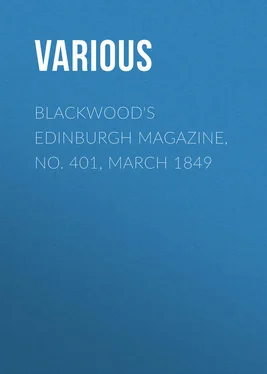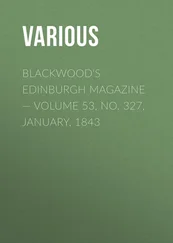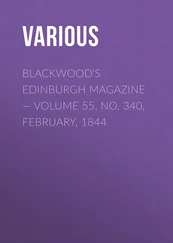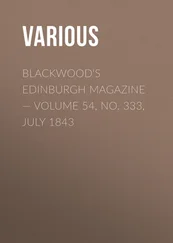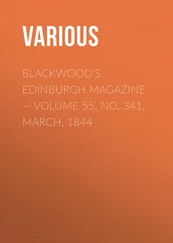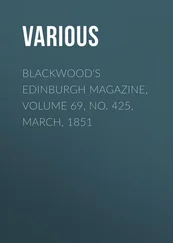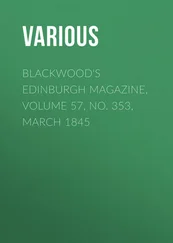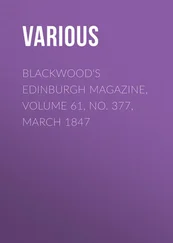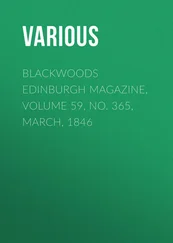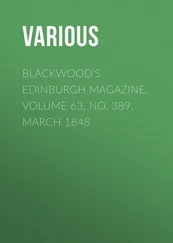Various - Blackwood's Edinburgh Magazine, No. 401, March 1849
Здесь есть возможность читать онлайн «Various - Blackwood's Edinburgh Magazine, No. 401, March 1849» — ознакомительный отрывок электронной книги совершенно бесплатно, а после прочтения отрывка купить полную версию. В некоторых случаях можно слушать аудио, скачать через торрент в формате fb2 и присутствует краткое содержание. Издательство: Иностранный паблик, Жанр: periodic, foreign_edu, Путешествия и география, на английском языке. Описание произведения, (предисловие) а так же отзывы посетителей доступны на портале библиотеки ЛибКат.
- Название:Blackwood's Edinburgh Magazine, No. 401, March 1849
- Автор:
- Издательство:Иностранный паблик
- Жанр:
- Год:неизвестен
- ISBN:нет данных
- Рейтинг книги:4 / 5. Голосов: 1
-
Избранное:Добавить в избранное
- Отзывы:
-
Ваша оценка:
- 80
- 1
- 2
- 3
- 4
- 5
Blackwood's Edinburgh Magazine, No. 401, March 1849: краткое содержание, описание и аннотация
Предлагаем к чтению аннотацию, описание, краткое содержание или предисловие (зависит от того, что написал сам автор книги «Blackwood's Edinburgh Magazine, No. 401, March 1849»). Если вы не нашли необходимую информацию о книге — напишите в комментариях, мы постараемся отыскать её.
Blackwood's Edinburgh Magazine, No. 401, March 1849 — читать онлайн ознакомительный отрывок
Ниже представлен текст книги, разбитый по страницам. Система сохранения места последней прочитанной страницы, позволяет с удобством читать онлайн бесплатно книгу «Blackwood's Edinburgh Magazine, No. 401, March 1849», без необходимости каждый раз заново искать на чём Вы остановились. Поставьте закладку, и сможете в любой момент перейти на страницу, на которой закончили чтение.
Интервал:
Закладка:
"An ox without horns is dodded or humbled .
"A castrated bull is a segg . A quey-calf whose ovaries have been obliterated, to prevent her breeding, is a spayed heifer or quey ."
Those of the horse are fewer, and more generally known —
"The names commonly given to the different states of the horse are these: – The new-born one is called a foal , the male being a colt foal , and the female a filly foal . After being weaned, the foals are called simply colt or filly , according to the sex, which the colt retains until broken in for work, when he is a horse or gelding which he retains all his life; and the filly is then changed into mare . When the colt is not castrated he is an entire colt ; which name he retains until he serves mares, when he is a stallion or entire horse ; when castrated he is a gelding ; and it is in this state that he is chiefly worked. A mare, when served, is said to be covered by or stinted to a particular stallion; and after she has borne a foal she is a brood mare , until she ceases to bear, when she is a barren mare or eill mare ; and when dry of milk, she is yeld . A mare, while big with young, is in foal . Old stallions are never castrated."
Those of the pig are as follows —
"When new-born, they are called sucking pigs , or simply pigs ; and the male is a boar pig , the female sow pig . A castrated male, after it is weaned, is a shot or hog . Hog is the name mostly used by naturalists, and very frequently by writers on agriculture; but, as it sounds so like the name given to young sheep, (hogg,) I shall always use the terms pig and swine for the sake of distinction. The term hog is said to be derived from a Hebrew noun, signifying 'to have narrow eyes,' a feature quite characteristic of this species of animal. A spayed female is a cut sow pig . As long as both sorts of cut pigs are small and young, they are porkers or porklings . A female that has not been cut, and before it bears young, is an open sow ; and an entire male, after being weaned, is always a boar or brawn . A cut boar is a brawner . A female that has taken the boar is said to be lined ; when bearing young she is a brood sow ; and when she has brought forth pigs she has littered or farrowed , and her family of pigs at one birth form a litter or farrow of pigs."
The diseases of cattle, horses, pigs, and poultry, are treated of – their management in disease, that is, as well as in health. And it is one of the merits of Mr Stephens that he has taken such pains in getting up his different subjects – that he seems as much at home in one department of his art as in another; and we follow him with equal confidence in his description of field operations, of servant-choosing and managing, of cattle-buying, tending, breeding, feeding, butchering, and even cooking and eating – for he is cunning in these last points also.
His great predecessor Tucker prided himself, in his " Five hundred points ," in mixing up huswifry with husbandry: —
"In husbandry matters, where Pilcrow 3 3 Where ¶ ( pilcrow ,) or paragraph, is placed at the side of the verse.
ye find,
That verse appertaineth to Huswif'ry kind;
So have ye more lessons, if there ye look well,
Than huswif'ry book doth utter or tell."
Following Tucker's example, our author scatters here and there throughout his book much useful information for the farmer's wife; and for her especial use, no doubt, he has drawn up his curious and interesting chapter on the treatment of fowls in winter. To show how minute his knowledge is upon this point, and how implicitly therefore he may be trusted in greater matters, we quote the following: —
"Every yellow-legged chicken should be used, whether male or female – their flesh never being so fine as the others." "Young fowls may either be roasted or boiled, the male making the best roasted, and the female the neatest boiled dish." "The criterion of a fat hen, when alive, is a plump breast, and the rump feeling thick, fat, and firm, on being handled laterally between the finger and thumb."
"Of a fat goose the mark is, plumpness of muscle over the breast, and thickness of rump when alive; and in addition, when dead and plucked, of a uniform covering of white fat under a fine skin on the breast." "Geese are always roasted in Britain, though a boiled goose is not an uncommon dish in Ireland; and their flesh is certainly much heightened in flavour by a stuffing of onions, and an accompaniment of apple sauce."
We suppose a boiled goose must be especially tasteless, as we once knew an old schoolmaster on the North Tyne, whose very stupid pupils were always christened boiled geese .
The threshing and winnowing of grain, which forms so important a part of the winter operations of a farm, naturally lead our author to describe and figure the different species of corn plants and their varieties, and to discuss their several nutritive values, the geographical range and distribution of each, and the special uses or qualities of the different varieties.
Widely spread and known for so many ages, the home or native country of our cereal plants is not only unknown, but some suppose the several species, like the varieties of the human race, to have all sprung from a common stock.
"It is a very remarkable circumstance, as observed by Dr Lindley, that the native country of wheat, oats, barley, and rye should be entirely unknown; for although oats and barley were found by Colonel Chesney, apparently wild, on the banks of the Euphrates, it is doubtful whether they were not the remains of cultivation. This has led to an opinion, on the part of some persons, that all our cereal plants are artificial productions, obtained accidentally, but retaining their habits, which have become fixed in the course of ages."
Whatever may be the original source of our known species of grain, and of their numerous varieties, it cannot be doubted that their existence, at the present time, is a great blessing to man. Of wheat there are upwards of a hundred and fifty known varieties, of barley upwards of thirty, and of oats about sixty. While the different species – wheat, barley, and oats – are each specially confined to large but limited regions of the earth's surface, the different varieties adapt themselves to the varied conditions of soil and climate which exist within the natural geographical region of each, and to the different uses for which each species is intended to be employed.
Thus the influence of variety upon the adaptation of the oat to the soil, climate, and wants of a given locality, is shown by the following observations: —
"The Siberian oat is cultivated in the poorer soils and higher districts, resists the force of the wind, and yields a grain well adapted for the support of farm-horses. The straw is fine and pliable, and makes an excellent dry fodder for cattle and horses, the saccharine matter in the joints being very sensible to the taste. It comes early to maturity, and hence its name."
The Tartarian oat, from the peculiarity of its form, and from its "possessing a beard, is of such a hardy nature as to thrive in soils and climates where the other grains cannot be raised. It is much cultivated in England, and not at all in Scotland. It is a coarse grain, more fit for horse-food than to make into meal. The grain is dark coloured and awny; the straw coarse, harsh, brittle, and rather short."
The reader will see from this extract that the English "food for horses" is, in reality, not the same thing as the "chief o' Scotia's food;" and that a little agricultural knowledge would have prevented Dr Johnson from exhibiting, in the same sentence, an example of both his ignorance and his venom.
Читать дальшеИнтервал:
Закладка:
Похожие книги на «Blackwood's Edinburgh Magazine, No. 401, March 1849»
Представляем Вашему вниманию похожие книги на «Blackwood's Edinburgh Magazine, No. 401, March 1849» списком для выбора. Мы отобрали схожую по названию и смыслу литературу в надежде предоставить читателям больше вариантов отыскать новые, интересные, ещё непрочитанные произведения.
Обсуждение, отзывы о книге «Blackwood's Edinburgh Magazine, No. 401, March 1849» и просто собственные мнения читателей. Оставьте ваши комментарии, напишите, что Вы думаете о произведении, его смысле или главных героях. Укажите что конкретно понравилось, а что нет, и почему Вы так считаете.
